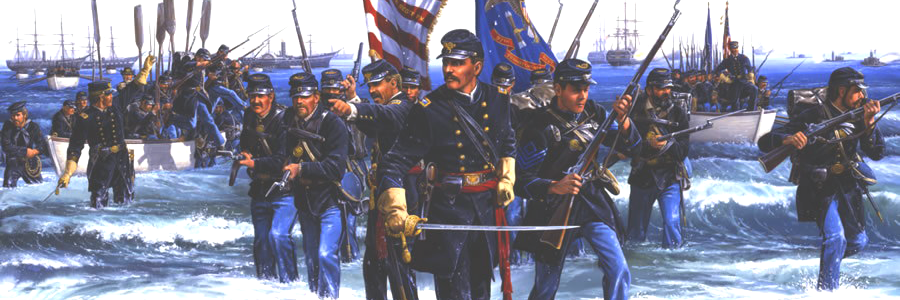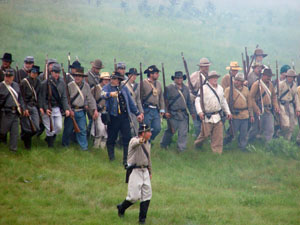
Fort Fisher State Recreation Area
1000 Loggerhead, Kure Beach, NC 28449 (910) 458-5798
Park Hours
November - February, 8 a.m. - 6 p.m.
March - October 8 a.m. - 8 p.m.
June - August, 8 a.m. - 9 p.m. Closed Christmas Day
Park Office Hours - Open most state holidays
8 a.m. - 5 p.m. daily
E-mail: fort fisher@ncdenr.gov
The Fort Fisher State Recreation Area contains the remainder of the batteries. Still existing, but hard to distinguish among the sand dunes, are the remains of Batteries Lenoir, Hendrick(behind the Visitor Center), Lamb and the Mound.
North Carolina Coastal Defense System
The Surrender of the Cape Fear Defense
Until the last few months of theCivil War, Ft Fisher kept North Carolina's port of open to blockade runners supplying necessary goods to Confederate armies inland. By 1865, the supply line through Wilmington was the last remaining supply route open to Robert E. Lee's Army of Northern Virginia.
When Ft. Fisher fell after a massive Federal amphibious assault on January 15, 1865, its defeat helped seal the fate of the Confederacy. Visitors are invited to tour the remains of the fort's land face featuring an impressive reconstruction of a 32-pounder seacoast gun at Shepard's Battery. Shaded by gnarled live oaks, a scenic trail leads tourists from the visitor center past the gigantic earthworks and around to the rear of the fort. Guided tours and wayside exhibits provide historical orientation. Other exhibits include items recovered from sunken blockade runners.
At the dawn of the American Civil War, the Confederacy took control of a neck of land in southern North Carolina near the mouth of the Cape Fear River and constructed what was to become the largest and most important earthwork fort in the South. Two major battles were fought there, and many Union soldiers received the Congressional Medal of Honor for their gallant participation in that fighting. Today only a few of the mounds remain, since much of the fort has been eroded by the ocean.
Colonel William Lamb recognized the importance of Fort Fisher to the defense system of the Cape Fear, to the security of Wilmington, and to the survival of the entire Confederacy. Massive and powerful, Fort Fisher kept Federal blockading ships at a distance from the Cape Fear River, protecting Wilmington from attack and ensuring relatively safe passage for Confederate naval travel. Wilmington was the last major port open to the Confederacy and the destination of steamers called blockade runners, which smuggled provisions into the Southern states and supplied General Lee's Army of Northern Virginia. These ships traveled from Bermuda, the Bahamas, and Nova Scotia, where southern cotton and tobacco were exchanged for food, clothing, and munitions from British traders.
The Union army and navy planned several attacks on Fort Fisher and the port of Wilmington, but made no attempt until December 24, 1864. After two days of fighting with little headway, Union commanders concluded that the fort was too strong to assault and withdrew their forces. However, they returned for a second attempt on January 12, 1865. For two and one-half days, Federal ships bombarded the fort on both land and sea face. On the fifteenth, more than 3,300 Union infantry, including the 27th US Colored Troops, assaulted the land face. After several hours of fierce hand-to-hand combat, Federal troops captured the fort that night.
The Confederate army evacuated their remaining forts in the Cape Fear area, and within weeks Union forces overran Wilmington. Once Wilmington fell, the supply line of the Confederacy was severed, and the Civil War was soon over. Today, Approximately ten percent of Fort Fisher still stands along with a restored palisade fence. All tours of the grounds begin in the visitor center. This recently renovated facility contains an audiovisual program that presents the history of the fort.


